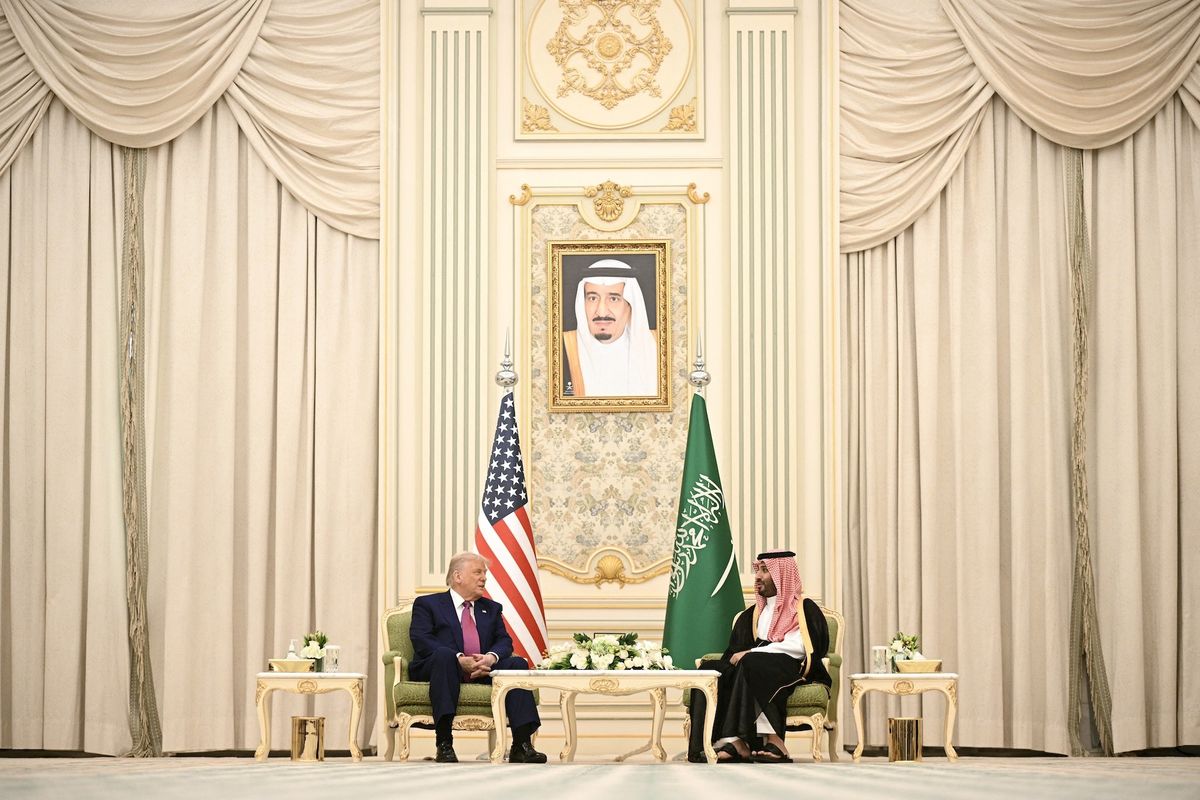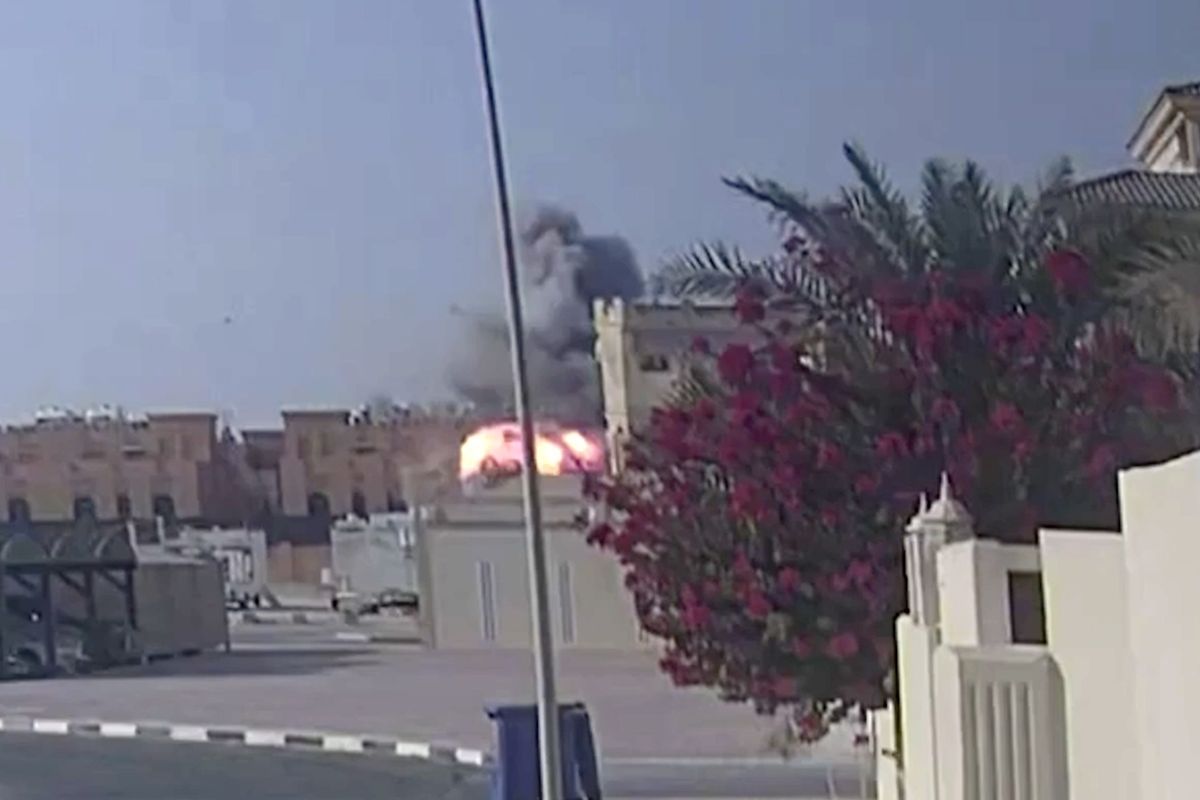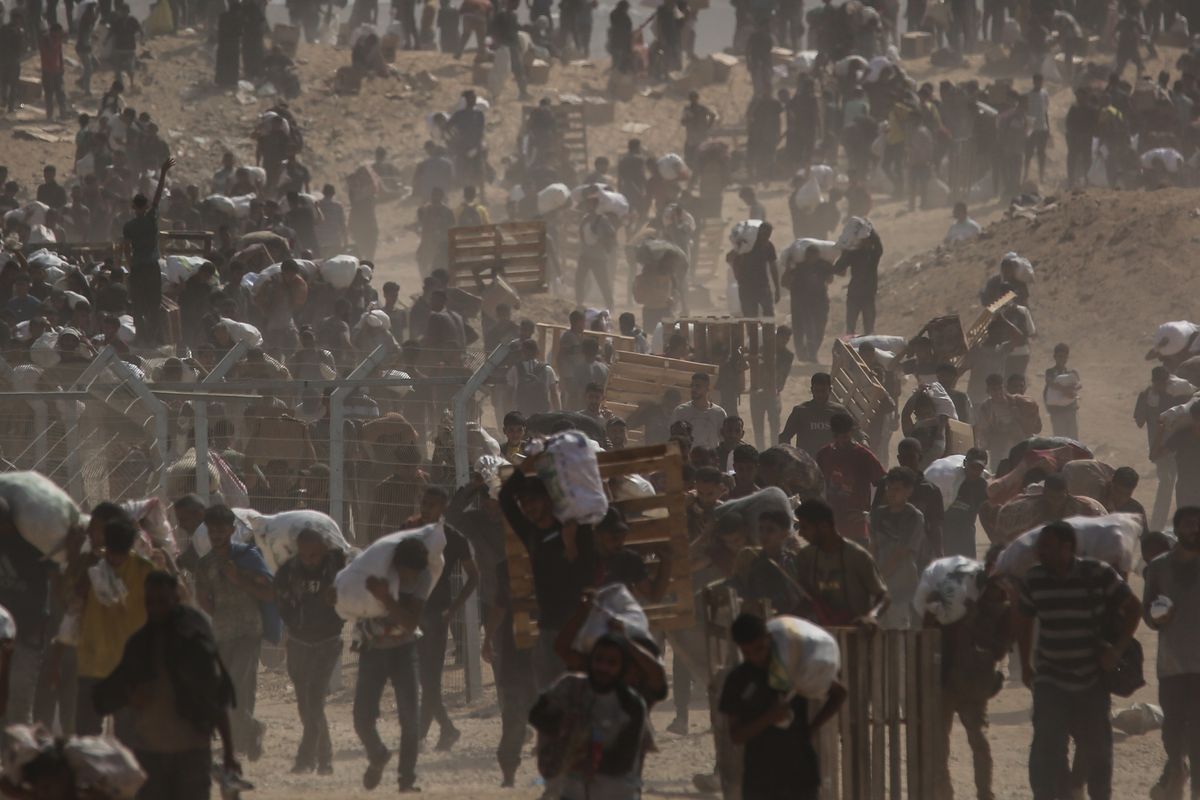SUBSCRIBER+EXCLUSIVE INTERVIEW – Since the killing of Hamas political leader Ismail Haniyeh in Tehran nearly two weeks ago, world leaders are urging calm while waiting to see whether further escalation could ignite a broader war in the Middle East, a region former U.S. intelligence officers are referring to as ‘tinder box’.
Iran’s Supreme Leader Ali Khamenei has publicly vowed revenge for the killing and according to some reports, has called for a direct strike against Israel. Other regional analysts speculate that Tehran may choose to go after individuals associated with the attacks instead.
Iran blames Israel for the attack though Jerusalem has not claimed responsibility.
The U.S. began moving additional assets to the region within days of the assassination, including the USS Wasp amphibious ready group/marine expeditionary unit operating in the eastern Mediterranean.
The Cipher Brief spoke with former National Intelligence Manager for Iran, Norm Roule, who regularly meets with leaders in the region, for his take on the increased tensions, the impact being felt across the region and beyond and the spoilers that could push the region closer to a broader war.
The Cipher Brief: Iran’s Supreme Leader Khamenei has reportedly ordered a direct military strike on Israel in response to the killing of Ismail Haniyeh. If true, what could this look like?
Roule: If true, this is a rare, direct order that can’t be ignored. The blow to Iran’s pride – to the dignity of the Supreme Leader himself – has been significant. Haniyeh died within hours of meeting Khamenei and Iran’s new president Masoud Pezeshkian, shortly after the latter’s inauguration. Every future history of the inauguration will mention this attack. Although the Netanyahu government has not taken responsibility for Haniyeh’s death, Iran’s security forces perceive this as one more humiliation at the hands of Israel.
The Cipher Brief: What factors will Iran’s leadership use to define ‘success’ in its retaliation?
Roule: First, they must demonstrate to their hardline base that Iran has reset deterrence without risking a regime-threatening conventional war. Retaliation must restore proxy confidence in Iran as a potent partner, and this means that proxies are likely to play a role in that retaliation. Last, Tehran needs to message the region, the U.S., and the EU that Iran will respond offensively to deter further attacks.
Ideally for Tehran, its retaliation would also keep the U.S. and Israel mired in a diplomatic quagmire, prevent any coalitions from forming against Iran, and end with Iran seen as a required stop for regional diplomacy.
The Cipher Brief: What are the constraints on Iran’s planning?
Roule: Domestically, the crisis arrives at a time when Iran’s national stability is fragile. Its people are disillusioned with years of economic mismanagement. Election turnout has collapsed. The transition to a post-revolutionary era of leadership has begun, and the Supreme Leader must deal with an untested new president.
The world has changed since Iran’s April attack on Israel. Tehran’s response options are predictable: missiles, drones, proxies, cyber operations, terrorism, naval mines, and submarines. However, the substantial military and intelligence capabilities of Israel, the U.S., and other partners significantly reduce the potency and perhaps even the utility of these tools.
Israel, the US, and other partners are prepared to respond to Iran’s missiles and drones. Tehran suffered an embarrassing defeat in April as its adversaries easily defended Israel from these same weapons. It isn’t hard to imagine that a repeat attack won’t have the same result.
The current U.S., Israeli, and partner military presence in the region is substantial, experienced, coordinated, and well-led. The carrier Theodore Roosevelt is reportedly positioned near the Strait of Hormuz. Multiple missile destroyers are deployed in the Red Sea and Arabian Sea. A large international amphibious naval force sits in the eastern Mediterranean.
Rarely has the U.S. had so many advanced aircraft in the region of a type and number far beyond the defense capabilities of Iran and its proxies. The current stable aircraft include F-35s, F-22s, and F-18s. U.S. B-2 bombers periodically operate in the region and may also be present. The latter aircraft carry the 30,000-pound GBU-57 Massive Ordnance Penetrators, our largest conventional ordnance.
Israel’s air defense personnel are rivaled only by Ukrainian counterparts in experience. Regional countries will not want to become involved in any Iran-Israel fight, but neither will they tolerate Iran using their airspace for missile and drone attacks on Israel. In short, Iran and its proxies face layers of defenses that rely on the most sophisticated and successfully tested air defense weapons on the planet.
Next, we have the issue of Iran’s proxies. These remain a formidable and long-term threat but have been significantly degraded in recent months.
Hamas remains a violent threat, but Israel has destroyed its strategic capabilities. Following the death of Ismail Haniyeh, the group could muster only nineteen rockets against Israel. I don’t recall seeing any reports that the Palestine Islamic Jihad responded to Haniye’s death.
The Houthis have used these weapons to severely reduce shipping to Eilat as well as to damage the global economy as well as. But U.S.-led attacks in recent months have severely reduced Houthi capability. Houthi attacks will continue, but their ability to launch large salvos of missiles and drones against Israel is unlikely. Iraqi militias are comparatively untouched by U.S. and other actors, but their missile and drone capability against Israel has, to date, been limited.
This leaves Lebanese Hezbollah, Iran’s most potent proxy. Hezbollah’s missiles and drone capabilities are well-known, but this is a different fight for Israel from Iran. If Iran is a fight of defense to avoid expanding the conflict, Israel has shown little reluctance in attacking Hezbollah leaders directly behind the attacks. In short, if the Iran challenge is defending against the “arrows,” responding to Hezbollah includes that defense but also a plan to neutralize the “archers” more aggressively. Hezbollah has lost around three hundred personnel since it began its attacks on Israel, including dozens of its most seasoned commanders. If the killing of Haniyeh implies exceptional intelligence and targeting, the deaths of Hezbollah military official Fuad Shakr and Hamas senior official Saleh al-Arouri in January show similarly strong intelligence along with surgical attack skills. One must, therefore, wonder the extent to which Hezbollah’s leaders believe they can launch an attack without Israel spotting preparations and attempting to disrupt Hezbollah’s command and control pre-launch operations. Last, Hezbollah is unlikely to launch a domestically unpopular war that could threaten the lives of its senior-most leadership and strategic capabilities to avenge the death of a replaceable Hamas leader.
Unless constrained further by military or diplomatic steps, an Iranian and Lebanese Hezbollah attack against Israel remains likely. However, the attack plan must be developed within this framework. Until a plan is developed, Iran and Hezbollah will exploit the diplomatic engagement offered by Western efforts to de-escalate tensions.
The Cipher Brief: What about the effects of regional instability on the global economy and energy markets and the broader issue of what an expanded conflict would mean?
Roule: Absent a significant expansion of the war, the risk posed by the conflict has already been priced into the equity and energy markets. Addition pressure on energy is unlikely absent strikes on Iran or Israel’s energy facilities. Oil rarely moves through the war zone. Oil shipments generally travel east to Asia or already move around Africa to Western clients. LNG shipments have been rerouted with some inflationary impact, particularly with such Mediterranean consumers as Greece. Gas production in the eastern Mediterranean has periodically halted, but not enough to impact the broader market.
There have been, unfortunately, significant economic consequences of the Red Sea conflict. The disruption of shipping brought new costs for global consumers. The Red Sea conflict threatens twelve percent of annual global trade. I think that’s about a trillion dollars’ worth of goods. It remains a mystery to me as to why this isn’t more widely discussed. NATO countries are touched directly by this problem, but the crisis didn’t seem to warrant much attention at the recent NATO conference in Washington.
Despite superb work by the U.S.-led naval coalition, we have seen dozens of Houthi attacks, at least two ships sunk, and a number of seafarers dead. The cost of this defense has already been measured in the billions of dollars.
An April Defense Intelligence Agency report stated that container shipping in the Red Sea has declined by ninety percent, with vessels diverted around Africa. Egypt has suffered a tremendous loss of Suez revenues, somewhere between 50-60 percent. Year-on-year, the Suez Canal saw a drop in transits by more than 5,000 vessels.
Fuel and related costs mean that each diverted container ship voyage is now about a million dollars more expensive. In 2023, the average cost to ship a standard forty-foot shipping container was under $1700. It is now around $6,000.
The Cipher Brief: How would an expanded conflict impact economies in the region?
Roule: If this is a Lebanon-Israel fight with minimal Iranian involvement, the primary impact would obviously be on Jerusalem and Beirut. My sense is that neither of these actors wants to turn this into a war between cities, but this could happen if either were to be perceived to be targeting ports, airports, or industrial targets.
A broader war would hit Lebanon’s already crippled economy hard. The country is dealing with insurmountable banking and debt problems. Its currency has lost ninety percent of its value in the last five years. It is difficult to estimate the exact impact of an expanded Israeli-Lebanon conflict, but if this happens, I wouldn’t be surprised if the Lebanese economy contracted a further fifteen to twenty per cent. We shouldn’t ignore the positive possibilities of a diplomatic solution. A cease fire or political deal with Israel would spur domestic construction.
Let’s move to Iran. President Pezeshian’s economic problems are immense, and his election victory was based on his promise to improve Iran’s economy. He inherited a country in which more than a third of university graduates are unemployed. Iran’s inflation hovers around forty-five percent. Some food items rose by as much as one hundred percent in 2023. It is a sad fact that the caloric intake of the average Iranian has fallen over twenty percent in recent years.
Iran’s GDP has expanded, hitting about 4.7 percent last year. But much of this success is due to Iran’s ability to evade sanctions and export oil or government spending. If the war expands and touches Iran’s oil sector, this will choke off precious revenue as well as Iran’s already modest hopes for foreign investment. Iran’s leaders would likely worry that an expanded war would bring serious risks to domestic political stability.
Israel would also be hit hard. Its shipping and transportation sectors have already suffered, in part due to Houthi attacks. Jerusalem has increased borrowing to cover the costs of war, and some of its most productive workers are now fighting in Gaza or training for Lebanon. This has cost both foreign earnings and tax revenue. Expansion of the conflict would further constrain productivity and investment and likely lead to another credit rating downgrade.
The Cipher Brief: The Cipher Brief recently sat down with the outgoing director of the National Counterterrorism Center, Christine Abizaid, and one of the issues brought up was the fact that Iran is still actively plotting to take revenge for the killing of General Qasem Soleimani in January of 2020. Tehran obviously has a lot of patience when it comes to how, when and where it retaliates. Talk to us about this problem.
Roule: Iran has indeed used the killing of Qasem Soleimani as an alleged motive for its threats against U.S. officials. But this is likely less a question of revenge and more a result of the current deterrent climate and Iran’s effort to project power. If you look at the history of Iranian assassinations, abductions, harassment, and threat actions since 1979, you see global attacks with explanations that seem more like cover for a state policy of extraterritorial attacks. Iran’s targets have been dissidents, journalists, foreign officials, tourists, and others.
The attacks sometimes take place while the West is seeking to defuse tensions and engage. They also sometimes occur in countries from which Iran is seeking diplomatic or trade concessions. Iran sometimes claims these operations are retaliation for attacks against its territory. In some cases, this was likely correct. But the broad geography and history of the attacks suggest a large bureaucracy that points to power projection through terrorism.
The Cipher Brief: What would it take to deter Iran’s terrorism? Many of its operations involve third-party or unofficial actors.
Roule: Iran’s leaders must believe that aggression will impact the survival of the regime. If the international community continues to treat Iran’s terrorism and external threats as a law enforcement problem, we likely guarantee that these operations will continue.
There is a reason for urgency. Iran’s use of generally untrained actors for its terrorism encourages the use of weapons that require little precision, i.e., explosives. This means an Iranian terrorist operation is likely to be a mass casualty event.
As to why Iran uses third-country or criminal actors, such personnel are difficult to identify and expendable. Even an unsuccessful operation using such personnel sends a propaganda message.
The Cipher Brief: What would you advise today when it comes to the levers of deterrence?
Roule: This isn’t our fight alone, but it is a fight in which failure brings lethal consequences. We need partners to make our pressure campaign effective, and we shouldn’t tolerate partners who fight only with rhetoric and leave us to do the hard work. When we do confront Iran, we should expect Tehran to test our fortitude. Iran’s leaders will publicly or privately threaten violence or nuclear expansion, take hostages, or even conduct an attack in the hope that the threat of escalation will encourage concessions on our part.
Two specific and long-overdue steps come to mind. First, the international community needs to compel Iran to end the operations of the Quds Force. Its personnel should be treated like terrorists and not uniformed personnel. Iran remains unique in its projection of terrorism in the guise of a traditional military structure.
Next, we need to be clear that terrorism by Iran in our country or against our personnel will result in a military attack on Iran. We somehow find ourselves in a world where Iran can attack civilians in multiple countries with explosives, yet responses against its own territory are deemed off-limits. I know this will be controversial to some, but the proposal reflects policies that Presidents Reagan and Clinton used in their administrations. Above all, we need to drop the idea that we can stop Iranian terrorism through symbolic sanctions or denying visas to the children of its officials. Absent restoring deterrence, we risk Iran achieving a catastrophic success that might result in the very war we are trying to avoid.
The Cipher Brief: With a new incident escalating tensions almost daily now, what are the indicators you're watching for that might be early warning signs of what’s ahead?
Roule: Multiple red indicator lights are now flashing. I've been watching the region for more than 40 years. I've never seen the region so fragile and on the cusp of so many conflicts.
The initiative seems to rest in the hands of spoilers, who can sometimes be partners. The purpose of regional partnerships seems unclear. Western intent remains undefined, and red lines are increasingly rare. We should all be concerned that the region is moving into truly unknown territory.
Read more expert-driven national security insights, perspective and analysis in The Cipher Brief because National Security is Everyone’s Business.













